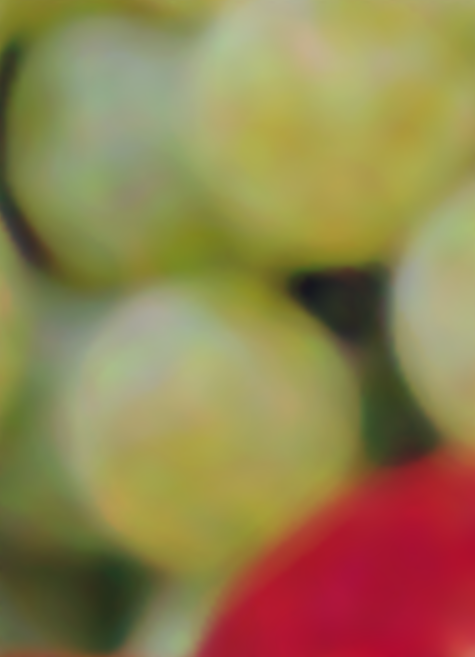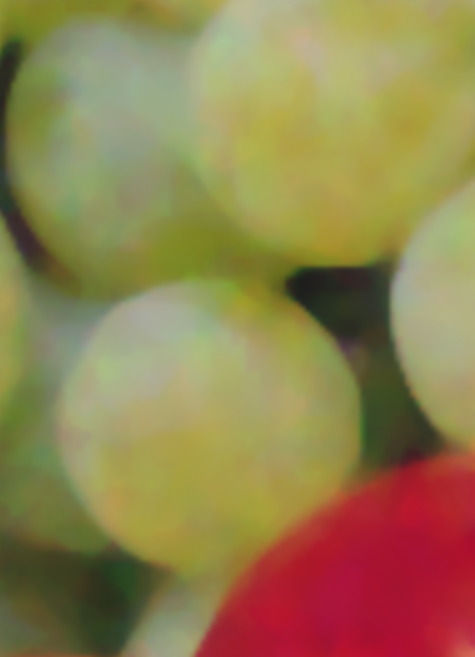
Difference: GMT_4YP_17_3 (r2 vs. r1)
Dr Graham Treece, Department of Engineering
F-GMT11-3: Image processing with structurally-varying morphological operators
 |  |  |  |
| This is a typical natural image of some grapes, with a fairly high level of additional noise. Removing such noise is a very common image processing operation. | A typical Gaussian filter removes noise well but also blurs the edges a lot in the process | There are countless more complex linear filters that improve on this result. However, Morphological it is also possible to use morphological operators to (non-linear do so. These are non-linear and use data ranking (sorting). They hence involving sorting the data) are much less common, but they naturally preserve edges and are insensitive to threshold levels. | Morphological operators rely on a local structuring element. In contrast to linear filters, there has been very little work on trying to locally vary this structuring element - but as can be seen from the image above, such local variation has much potential. |
Bone fracture is Digital image filters, a major issue affecting millions of people annually, and we have recently been involved in research which has the potential to contribute significantly to both our replace each pixel in an image with some combination understanding of fracture pixels and how various preventative measures affect bone. The advances have come from a much more precise (and hence local neighbourhood, are extremely useful much more sensitive) measurement of the bone cortex (the denser layer surrounding the less dense bone in the middle). As well as contributing image processing. Of particular note are those which attempt to our understanding reduce noise levels in an image whilst preserving the location and extent of fracture, any feature gradients, or 'edges'. Multiple linear filters have been developed for this technique purpose, is also being used to underpin models of bone used in mechanical analysis, for instance to see what happens to the skull during anisotropic diffusion, non-local means and image-guided filtering. These a head injury. It is also increasingly being used by paleo-anthropologists who are interested in the properties of all able to automatically adjust very old bones. whichpixels are used in the local neighbourhood around each pixel to give the best reduced-noise new estimate.
The existing technique expects Morphological filters, which rely on data ranking rather than level, have received much less attention. This is despite their inherent insensitivity to measure a the extent single 'layer' of bone, but in many places bone has more an edge which should make them good candidates than one layer: for instance in edge-preserving filtering. It has recently been demonstrated that the skull there are two layers: an inner bitonic filter, a morphological filter based on 'opening' and an outer table, 'closing' operations, can perform nearly as well as anisotropic diffusion and non-local means for noisy natural images. This is despite the use of a local 'structuring element' which in some places join does not automatically adjust together to become just one. In these areas it the data around each pixel. Hence there is not clear good reason whether our measurements relate to one or expect that local variation of the shape of this structuring element will significantly improve performance. However, there has been very little work on locally-varying morphological filters, partly perhaps due to difficulties in both tables. implementation and analysis. The aim of this project is to try to disentangle this information, by looking at measurements made investigate such filters, which could encompass implementation efficiency, what determines from either side of the bone, to local shape try to split them into clean sets of measurements of either the whole skull structuring element, thickness, or just the inner and outer a number of other avenues. tables. This is an interesting problem in computational geometry, but also in surface-based registration and visualisation
This is an algorithmic development / computational geometry / software project, so experience of writing software is essential, though the development could also be done using Matlab.
Click here for other imaging projects offered by Graham Treece.
| I | Attachment | Action | Size | Date | Who | Comment |
|---|---|---|---|---|---|---|
| grapes_bitonic_fixed.png | manage | 172.7 K | 24 Mar 2017 - 12:22 | UnknownUser | ||
| grapes_bitonic_varying.png | manage | 181.5 K | 24 Mar 2017 - 12:23 | UnknownUser | ||
| grapes_gaussian.png | manage | 160.8 K | 24 Mar 2017 - 12:22 | UnknownUser | ||
| grapes_noise.png | manage | 490.4 K | 24 Mar 2017 - 12:22 | UnknownUser |